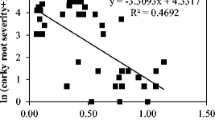Abstract
Red clover (Trifolium pratense) is an important component of mixed grass-legume leys; however, fungal root rot decreases red clover viability over time. Application of micronutrients may be one option to reduce the severity of the pathogens causing root rot. This study investigated the relationship between micronutrient (B, Cu, Mn, Zn) concentrations in red clover roots and the development of root rot, and examined whether the addition of micronutrients reduced root rot development. A field study was performed in 2009 to determine root rot incidence in red clover plants collected from four different field leys and a pot experiment was conducted in 2010 to determine the effect of micronutrient application (B, Cu, Mn, Zn) on root rot development in red clover. Disease severity index (DSI) and nutrient concentrations were determined in the plants.
The field study found an inverse relationship between increasing micronutrient (Cu, Mn, Zn) concentrations in plant roots and decreasing internal DSI. Internal DSI decreased with low element translocation from root to shoot and with increased Mn in the root as a result of Mn and Zn application. In contrast, the application of B or Cu slightly increased internal DSI.
Thus, an inverse correlation exists between some micronutrients and severity of root rot in red clover. The addition of Mn and Zn can reduce root rot and thereby increase the sustainability of red clover.
Similar content being viewed by others
References
Andrist-Rangel Y, Simonsson M, Andersson S, Öborn I & Hillier S, 2006. Mineralogical budgeting of potassium in soil: A basis for understanding standard measures of reserve potassium. J Plant Nutr Soil Sc 169, 605–615.
Christensen MJ, Koga H, Tsukiboshi T & Uematsu T, 1994. Possible causes of poor persistence of red clover stands in Japan. BNGRI 499, 43–49.
Couleman BE & Lambert M, 1995. Selection for resistance to root rot caused by Fusarium spp. in red clover (Trifolium pratense L.). Can J Plant Sci 75, 141–146.
Datnoff LE, Elmer WH & Huber DM, 2007. Mineral nutrition and plant disease. APS Press, St. Paul, MN.
Dordas C, 2008. Role of nutrients in controlling plant diseases in sustainable agriculture: A review. Agron Sustain Dev 28, 33–46.
Frame J, Charlton JFL & Laidlaw AS, 1998. Temperate forage legumes. CAB International, MA, New York.
Hejduk S & Knot P, 2010. Effect of provenance and ploidity of red clover varieties on productivity, persistence and growth pattern in mixture with grasses. Plant Soil Environ 56, 111–119.
Huber DM, 1993. The role of nutrition in the take-all disease of wheat and other small grains. In: Engelhard A.W (ed.) 1993: Soilborne plant pathogens: management of diseases with macro- and microelements. The American Phytopathological Society, St. Paul, MN, pp 46–74.
Jones Jr B, Wolf B & Mills HA, 1991. Plant Analysis Handbook 1. Methods of Plant Analysis and Interpretation. Macro-Micro Publishing, Inc.
Kalim S, Luthra YP & Gandhi SK, 2003. Role of zinc and manganese in resistance of cowpea root rot. J Plant Dis Protect 110, 235–243.
Keel C, Voisard C, Berling CH, Kahr G & Défago G, 1989. Iron sufficiency, a prerequisite for the suppression of tobacco black root rot by Pseudomonas fluorescens strain CHA0 under gnotobiotic conditions. Phytopathology 79, 584–589.
Lager J & Gerhardson B, 2002. Pathogenicity of clover root pathogens to pea, bean and lucerne. J Plant Dis Protect 109, 142–151.
Leath KT, Lukezic FL, Pennypacker BW, Kendall WA, Levine RG & Hill Jr RR, 1989. Interaction of Fusarium avenaceum and Pseudomonas viridiflava in root rot of red clover. Phytopathology 79, 436–440.
Lewis JA, 1973. Effect of mineral salts on Aphanomyces euteiches and Aphanomyces root rot in peas. Phytopathology 63, 989–993.
Lindström J & McAfee M, 1989. Aeration studies on arable soil, 2: The effect of a grass ley or cereal on the structure of a heavy clay. Swed J Agr Res 19, 155–161.
Marschner H, 1995. Mineral Nutrition of Higher Plants. Academic Press, London.
Oliva RN, Steiner JJ & Young WC, 1994. Red clover seed production II. Plant water status on yield and yield components. Crop Sci 34, 184–192.
Pederson GA, Brink GE & Fairbrother TE, 2002. Nutrient uptake in plant parts of sixteen forages fertilized with poultry litter: nitrogen, phosphorus, potassium, copper, and zinc. Agron J 94, 895–904.
Pokorný R, Andersson B, Nedêlník & Ríha P, 2003. Current state of red clover breeding for resistance in central and Northern Europe. Czech J Genet Plant Breed 39, 82–85.
Prabhu AS, Fageria NK, Huber DM & Rodrigures F Á, 2007. Potassium and plant disease. In: Datnoff LE, Elmer WG, and Huber DM, (eds) 2007: Mineral nutrition and plant disease. APS Press, St Paul, MN pp 57–79.
Rengel Z & Jurkic V, 1992. Genotypic differences in wheat Al tolerance. Euphytica 62, 111–117.
Rufelt S, 1986. Studies on Fusarium root rot of red clover (Trifolium pratense L.) and the potential for its control. SLU. Dept. of Plant and Forest Protection, Uppsala. Doctoral thesis. 33 s.
SAS Institute, 2010. É SAS Institute Inc. Campus Drive, Building T, Cary, NC.
Schnoor JL, 1996. Modeling trace metals. In: Environmental modelling — Fate and transport of pollutants in water, air, and soil. John Wiley & Sons, Inc., USA, pp 381–451.
Wallenhammar A-C, Nilsdotter-Linde N, Jansson J, Stoltz E & L-Baeckström G, 2008. Influence of root rot on the sustainability of grass/legume leys in Sweden. Grassland Sci Eur 13, 341–343.
Wallenhammar A-C, 2010. Field Surveys of Fusarium root rot in Swedish organic red clover leys and susceptibility tests of Nordic cultivars. In: NJF Seminar 432. The potential of forage legumes to sustain a high agricultural productivity. Hvanneyri, Iceland, 20–22 June 2010.
Walters DR & Bingham IJ, 2007. Influence of nutrition on disease development caused by fungal pathogens: implications for plant disease control. Ann Appl Biol 151, 307–324.
Author information
Authors and Affiliations
Corresponding author
Rights and permissions
About this article
Cite this article
Stoltz, E., Wallenhammar, AC. Micronutrients reduce root rot in red clover (Trifolium pratense). J Plant Dis Prot 119, 92–99 (2012). https://doi.org/10.1007/BF03356427
Received:
Accepted:
Published:
Issue Date:
DOI: https://doi.org/10.1007/BF03356427




